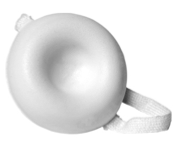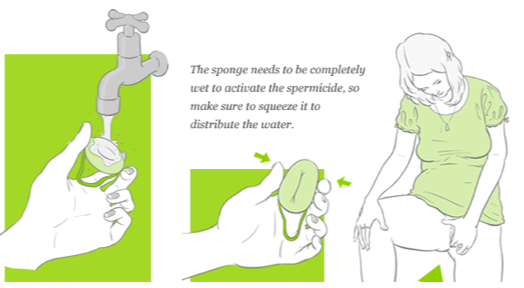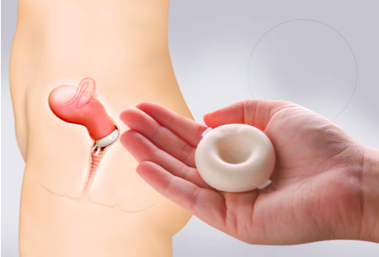The contraceptive sponge is a small, disposable polyurethane foam device that contains absorbed spermicide. It is soft, circular, and concave in shape, and it has an attached cotton loop used for insertion and removal.1,2 Before intercourse, the sponge must be inserted deep into the vagina and placed over the cervical opening in order to prevent pregnancy by killing sperm before they enter the uterus and fertilize an egg.2 In the United States, the only brand of contraceptive sponge that is available is the called the Today Sponge. In Europe and parts of Canada, the Protectaid Sponge and the Pharmatex Sponge are usually available.3

Table of Contents
How Does the Sponge Work?
The sponge prevents pregnancy by keeping sperm from coming into contact with an egg. The sperm is prevented from fertilizing the egg due to the spermicide in the sponge as well as the physical barrier created by the sponge.1
Spermicide is the primary method by which the sponge prevents pregnancy. The sponge comes pre-soaked with spermicide, and once it is activated with water and inserted, the spermicide is continually released into the vagina. The spermicide kills sperm and prevents them from moving towards an egg. Additionally, the sponge falls into the category of a barrier method of birth control because it covers the cervical opening, or “os,” and acts as a physical barrier, which blocks sperm from entering the uterus and prevents fertilization.1
How Effective is the Sponge?
Effectiveness should be taken into consideration when one is choosing a method of birth control. Different methods of birth control have different levels of effectiveness, and this level can also be influenced by the degree to which the method is used as directed. Unfortunately, the contraceptive sponge is one of the least effective methods of birth control; however, it is still better than using no contraceptives at all.4 It can be very effective when combined with other birth control methods, such as latex condoms.
The sponge is most effective for users that have not given birth vaginally.1,4,5 People who have given birth vaginally may have stretched cervixes as a result of the cervical dilation that occurs during vaginal birth. Even postpartum, when the cervix shrinks back from its dilated state, it seldom returns to its pre-birth size.6 The varieties of shapes and sizes that the cervix may take after vaginal birth can make attaining a good fit with the contraceptive sponge more challenging. As a result, the cervical sponge is most effective for people who have not previously given birth vaginally.1,4,5 We would like to point out that these effects are significant if one has given birth vaginally, but not if one has only given birth by other means, such as through a cesarian section (also known as a C-Section).1

When using the sponge alone, during typical use, the sponge has a 17% failure rate (“typical” use refers to using the sponge as someone usually would, including making a few mistakes). With perfect use (using the sponge exactly as directed, with no mistakes) the failure rate is 11-12%. A way to visualize this rate involves thinking about it as if 17 of every 100 people that use the sponge as their only form of contraception get pregnant each year. These failure rates are different for those who have given birth vaginally and those who have not: with perfect use, failure rates are closer to 9-10% for people who have not given birth, as compared to 19-21% for those who have.7
A partner can make the sponge more effective at preventing pregnancy if they use a latex condom. Withdrawing the penis before ejaculation may also sometimes be beneficial in this situation, but the “withdrawal method” (or “pull-out method”) often does not work because of the presence of sperm in pre-ejaculatory fluid and the chance of premature ejaculation. We also encourage you to remember that, without the use of a latex condom, the contraceptive sponge cannot protect you from sexually transmitted infections (STIs).1
Click here to compare the efficacy of this method of contraception with other methods of birth control in our contraceptive chart!
How Does One Use the Sponge?
With a bit of practice, the sponge is easy to use and can be inserted and removed from the vagina without difficulty.

Inserting the Sponge
- Before inserting the sponge, wash hands to prevent the introduction of germs into the vagina.
- Wet the sponge thoroughly with at least two tablespoons of water to activate the spermicide. Do not use saliva in place of water.
- Gently squeeze the sponge until it is foamy. The sponge should still be moist—do not squeeze all liquid from the sponge.
- Fold the sides of the sponge away from the removal loop to make it narrow. Place the sponge in the vagina with the dimpled side of the sponge going in first.
- Push the sponge as far as up the vagina as it will go. Make sure to do so gently, and avoid tearing the sponge with fingernails.
- The sponge will unfold and cover the cervix once released. One should be able to feel that the contraceptive sponge is situated flush against the cervix. The string loop side should be facing out (towards the vaginal opening) so that the cervix is tightly covered by the sponge.
- Slide fingers around the edges of the sponge to check its orientation and fit. The walls of the upper vagina will hold the sponge in place.1,5
While the sponge is inserted, the wearer is protected from pregnancy even if they have intercourse more than once. Once the sponge is removed, however, they will no longer be protected against pregnancy.1,3,4,5
How Long Should the Cervical Sponge Be Left In?
The length of time that a contraceptive sponge can be left inserted in the vagina varies by brand, so we recommend carefully reading the instructions on the packaging. The Today Sponge should not be left in place for more than 30 hours, the Pharmatex for more than 24 hours, and the Protectaid for more than 12 hours. One should keep in mind that each brand of sponge must also be left in place for a certain amount of time after intercourse in order to effectively prevent pregnancy. For the Today Sponge and the Protectaid Sponge, this time is 6 hours, and it is only 2 hours for the Pharmatex Sponge.3 One should ensure that they are prepared to leave the sponge against the cervix for the recommended amount of time.

Removing the Sponge
To remove the sponge from the vagina, follow these steps:
- Wash hands thoroughly with soap and water before inserting fingers into the vagina.
- To remove the device, pull the sponge out of the vagina using the string loop. If the sponge turns upside down, slide a finger around the edge of the sponge to find the loop, or grasp the edge of the sponge with two fingers and gently pull out. If the sponge sticks to the cervix, use a finger to lift the sponge away from the cervix on one side.
- If it is difficult to remove the sponge, relaxing the vaginal muscles and trying again may be helpful.
- After removal, check to make sure that the entire sponge has been removed.
- Throw the sponge away.
- In the rare situation that the sponge cannot be removed, professional medical care should be sought out.1,5
Once a sponge is removed, it should not be reinserted. Always discard a used sponge in a waste container. Do not flush a used cervical sponge down the toilet.1,4,5
What are the Advantages?
The contraceptive sponge is a safe, convenient, and simple method for preventing unwanted pregnancies. The sponge can be purchased at a drugstore without a prescription and does not require a fitting by a healthcare professional. With practice, inserting and removing the sponge can become simple.
Many users like the contraceptive sponge because of the following factors:
- It is small, portable, and inexpensive.
- It can be purchased at most drugstores or pharmacies.3
- Wearers do not need to see a doctor before using the contraceptive sponge (this method requires no prescription, fitting, nor professional insertion or removal).1,4,5
- It can be inserted up to one day before sex and does not interrupt sexual spontaneity.1,4,5
- The wearer can have intercourse an unlimited number of times without having to remove or reinsert the sponge.1,4,5
- It is discrete and confidential—a partner does not have to know the user is using it.1,5
- It provides the opportunity for the user to discover more of their own anatomy.
- It is hormone free and can be used while breastfeeding.1,4,5

One should consider what advantages they are looking for in their choice of birth control. Certain factors that are advantages to some individuals may not be desirable for others. If considering the contraceptive sponge, think about how well the use may accommodate your daily life.
What are the Disadvantages?
Like many other types of birth control, the contraceptive sponge is not without risk and has its disadvantages. Some people may dislike this method of birth control because of the following factors:

- It may be difficult for some potential users to reach their cervix, so the sponge may be difficult to insert and remove properly.4,5
- The risk of allergic reactions is higher for the sponge compared to other barrier methods of birth control, such as the diaphragm.1,5,8
- It may cause vaginal irritation.1,9
- It can increase the risk for urinary tract infection, toxic shock syndrome, vaginal infection, or inflammation of the cervix.1
- The spermicide in the contraceptive sponge can make performing oral sex on the wearer unsavory; many people have complained about the taste and “numbing” effect of the sponge.9
- The sponge may make sex “messier” because of the water required to activate the spermicide.9
- The sponge can also cause sex to be too dry because the sponge may absorb some of the user’s vaginal secretions. Using a water-based lubricant can help alleviate such dryness.9
- The spermicide absorbed into the sponge may contain nonoxynol-9, which has certain risks. If used multiple times a day for an extended period or by those at risk for HIV, the spermicide may irritate vaginal tissue and increase the risk of contracting an STI or HIV.1
Keep in mind that there are certain strategies one can use to cope with the various disadvantages of the sponge. For example, if a wearer or their partner enjoys oral sex and finds the taste of the sponge undesirable, they could try practicing oral sex before inserting the sponge.
Is the Sponge Right for You?
The contraceptive sponge is not as effective as other forms of birth control. It may, however, be a great option for individuals or couples who would not mind getting pregnant or for older individuals with lower fertility.5
The sponge may not be the correct contraceptive choice for you if you:
- Are uncomfortable with touching your vagina
- Are allergic to sulfa-based drugs or are irritated by polyurethane or spermicides
- Have recently had a vaginal childbirth, abortion, or miscarriage
- Have a vaginal, uterine, or cervical infection
- Have a history of toxic shock syndrome.
Do not use the sponge if you are experiencing any type of vaginal bleeding, including during menstruation. This can increase your risk of experiencing toxic shock syndrome. To minimize this risk, do not leave the sponge in place longer than 30 hours (or longer than directed on the packaging).1,4,5
Toxic shock syndrome is a rare but life-threatening complication of various types of bacterial infections. Often, toxic shock syndrome results from toxins that are released by staph or strep bacteria. Notify your physician immediately if you experience any symptoms of toxic shock syndrome. These symptoms include aching muscles and joints, diarrhea or vomiting, light-headedness or confusion, sore throat, sudden high fever, and a sunburn-like rash on the palms of hands or the soles of feet.10
What is the Cost & Availability of the Sponge?
According to the Today Sponge website, at the end of 2019, the manufacturers of the Today Sponge were unable to produce the product due to errors in their equipment. As of January 2022, the Today Sponge is out of stock on the company’s website, as well as in stores across the United States and in online storefronts such as Amazon.3,11 The company states that they are working to fix their equipment and resume production of the Today Sponge but also states that they are unsure if or when this may occur.11

Prior to the halt in production, prices for the Today Sponge were up to $15 for a pack of 3 contraceptive sponges. Contraceptive sponges were able to be purchased online or at drugstores, pharmacies, and family planning clinics. There was some variation in prices depending on where the sponges were purchased. The sponges may have been available at a lower rate or at no cost at Planned Parenthood and at other family planning clinics.9 It is also possible that if and when the production of the Today Sponge resumes in the United States, these prices and availability will be subject to change.
The Protectaid and Pharmatex sponges are still available for purchase in Europe and Canada and can be purchased online or over the counter at drug stores.3 Prices for the Protectaid and Pharmatex sponges are similar to that of the Today Sponge, but they may vary depending on which country they are purchased in.
Concluding Remarks
The contraceptive sponge is a small, circular device that is inserted into the vagina. It works by creating a physical barrier that prevents sperm from entering the uterus as well as by releasing spermicide into the vagina. It has declined in popularity over the years because it is not as effective a method of birth control as other forms of contraception. Many people still prefer to use the sponge, however, because it has various benefits, such as allowing the wearer to have protected intercourse multiple times without needing to change the sponge. The contraceptive sponge does not protect against STIs; the best protection against STIs is to use condoms as well. Using condoms or other methods of contraception alongside the cervical sponge will help to better protect against pregnancy.
References
1. UC Davis. (n.d.). Contraceptive sponge. UC Davis: Student health and counseling services.
2. Mayo Clinic. Contraceptive sponge. (n.d.). Healthy Lifestyle: Birth control.
3. Sponges. (2022). Cervical Barrier Advancement Society.
4. Harvard Medical School. (April 2021). Diaphragm, cervical cap, sponge. Harvard health publishing: Birth control center.
5. Birth control sponge. (n.d.). Bedsider.
6. Childbirth recovery and postpartum care. (September 11, 2009). About Kids Health.
7. Trussell J, Strickler J, Vaughan B. Contraceptive efficacy of the diaphragm, the sponge and the cervical cap. Family Planning Perspectives 1993; 25(3): 100-5 & 135
8. Kuyoh MA, Toroitich-Ruto C, Grimes DA, Schulz KF, Gallo MF. Sponge versus diaphragm for contraception: A Cochrane review. Contraception 2003; 67: 15-18.
9. Birth control sponge. (n.d.) Planned Parenthood.
10. Toxic shock syndrome. (March 18, 2020). Mayo Clinic.
11. Out of stock. (n.d.). Today Sponge.
Last Updated March 3, 2022.
